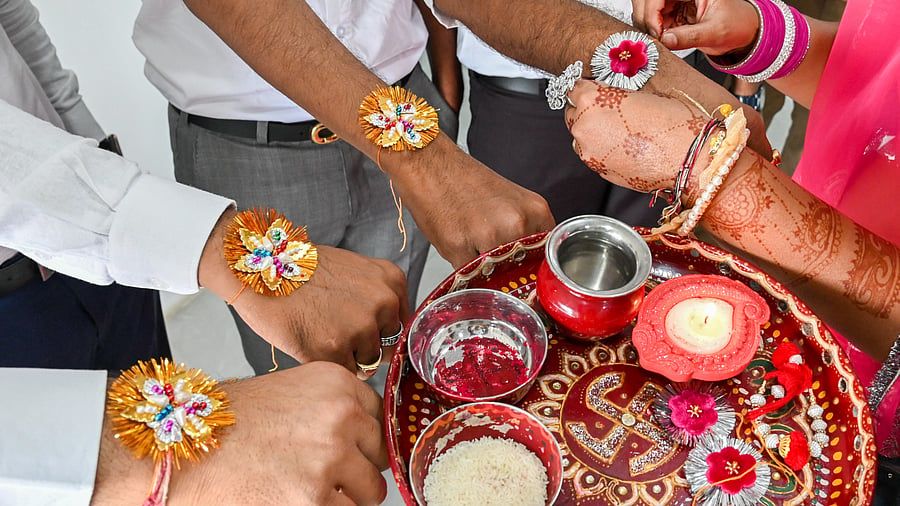
Raksha Bandhan .
Credit: DH Photo
This month, we celebrated the festival of Raksha Bandhan, or rakhi, as it is commonly called—a popular Hindu festival celebrated with gusto across many parts of India.
The name comes from the wristband, or rakhi, that sisters tie on the right hands of their brothers. This act is believed to symbolise the bond of love between a brother and sister and to embody a lifetime promise that the brother will defend his sister in the face of any adversity.
I grew up in a home where Rakhi was celebrated with zeal. I remember my parents coming together with my aunts, uncles, and the extended family to take part in the ritual. In many households, including mine, the festival follows a familiar, well-rehearsed script.
Traditionally, sisters observe a fast in the morning, breaking it only after tying the rakhi. They are responsible for making all the ritual arrangements—buying a rakhi in advance, preparing sweets, and gathering accompaniments such as coconut and kumkum. The sister performs an aarti, puts a tilak on the brother’s forehead and finally, ties a rakhi on his right wrist. In return, the brother presents her with money or some other gift as a token of his love.
The festival is customarily celebrated at the brother’s home. The brother either goes in advance to fetch his married sister from her affinal home for the occasion, or she travels to the brother’s place on her own for the purpose after securing due permission from her husband and affinal family elders. If she is unable to meet her brother for Rakhi due to large distances or another pressing reason, she remembers to send him the rakhi by post early enough so that it reaches him well in time for the festival.
Even in those cases where women enjoy a degree of financial independence and autonomy and the associated socio-economic advantages, a break from the established tradition is rare. The usual ‘rakhi routine’ is assiduously followed by families every year. The same set of rituals are repeated and reproduced, mostly without any questioning or critical scrutiny.
Women continue to adhere to and perform the prescribed rituals, either as a tenuous compromise with patriarchy or out of deference to accepted socio-religious codes. Very often, they themselves hold on to and willingly go along with the existing social and moral order.
They also try their best to maintain it at times, even if it works against them. In any event, resistance is difficult and involves its own costs.
The festival of Rakhi thus becomes an important social and ritual mechanism for upholding the status quo. It consolidates dominant patrilineal, patrilocal and patriarchal structures that work by default to the advantage of men and against women. Through festivals like Rakhi, these unequal power structures and relations receive sustenance. They continue to remain dominant, and resisting or breaking away from them becomes all the more challenging. Increasingly, they are even moulded and remoulded by glossy advertisements, popular culture and pressures from a market-driven modernity to fit the demands of changing times.
The festival of Rakhi dictates and concretises particular gender roles, relations, positions and expectations. In most homes where Rakhi is conventionally celebrated, children—whether boys or girls—often grow up internalising deeply gendered constructions about the roles that men (brothers) and women (sisters) are expected to perform. Rakhi, of course, is not alone in this. Many other festivals, rituals and religious/cultural celebrations that we regularly partake in are equally complicit in laying down explicitly gendered codes of behaviour. Such observances also serve to make sure that these established gendered codes are duly enacted and legitimised through repetition.
To break this cycle, we will have to call out the clearly gendered messaging built into many of our ritual and cultural practices and performances. Existing gendered messages embedded in popular festivals and rituals will have to be consciously subverted/inverted. Alternatively, many of these observances will have to be encoded with entirely new messaging.
Perhaps, the festival of Rakhi should then be pitched as an entry point to advocate equitable relationships between brothers and sisters and demand an end to discrimination against girl children by families and communities. Following from this, the festival can be creatively used to emphasise the need to forge mutual relationships, free from prejudice and gendered preferences, and rooted in parity, equality, respect, and, of course, familial care and love.
(The writer is an assistant professor of history at Azim Premji University, Bhopal)